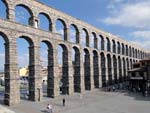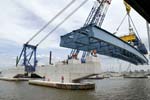
|

|
|
Home Site Search Contact Us Subscribe
|
|
INSIGHT: The Case for Permanent Infrastructure Water mains burst, gas mains explode, drinking water is poisoned by lead, bridges collapse, roads break down, vehicles collide, and trains derail. Are these the systems we want? What would be required, and when will we respond to this compelling need for change? By Peter Gisolfi, AIA, ASLA, LEED AP February 18, 2016 The word “infrastructure” is often mentioned when lamenting the deterioration of public roads, railroads, and utilities. By definition, infrastructure refers to the basic physical structures and facilities needed for the operation of society. It includes transportation – roads, railroads, harbors, airports – as well as sewers, sewage treatment plants, and water supply systems such as reservoirs, aqueducts, and water mains, along with electrical and natural gas systems, and communications systems. In essence, infrastructure serves as the backbone of our civilization.
It is generally acknowledged that the infrastructure in the United States is decaying. For example, the federal tax on gasoline used to be sufficient to build and maintain federal highways. But that tax money is no longer adequate to support those roads; costs have risen, but the tax has not increased since 1993.
When sentimental architects look back over their history, they often focus on the infrastructure of a Roman Colonial town. Typically, the town was located along a river with an adequate harbor. The town plan included streets, sewers, aqueducts, water pipes, walls, and gates, which were standardized and applied throughout the empire. What is fascinating is that 2,000 years later, fragments of the infrastructure of many Roman towns are still functioning.
Examples from ancient times • The Appian Way, the road that connects Rome to Naples, has been in existence for 2,300 years, and is still in use. Roman roads, which were typically the width of two chariots, were constructed of stone and laid on a crushed stone and gravel base, up to five feet in depth. Clearly, the Romans believed they were building a permanent road. Similar permanence was required of the aqueducts, the water pipes, the sewers, etc. • As another example, the Roman town of Verona, founded in the 1st Century BC, was located in a river valley in northern Italy. The arched Roman bridge Ponte Pietra, which spans the Adige, was built when the town was founded, and was in continuous use from ancient times until the Germans blew it up as they retreated from Italy in 1945. Remarkably, the Veronese collected the stones from the river and, in 1957, reconstructed the original bridge. • In Córdoba, Spain, the Roman bridge across the Guadalquivir River still functions as the entrance to the city. It was also constructed in the 1st Century BC. • The Pantheon in Rome continues to function as a temple (church) 1,900 years after it opened in 126 AD. • Ancient Roman aqueducts stand today as a testament to engineering precision. Water to the Trevi Fountain in Rome is supplied by the Aqua Virgo and the Acqua Vergine, ancient aqueducts constructed under the leadership of the Roman statesman, general, and architect Marcus Vipsanius Agrippa in 19 BC.
Examples from the present day • The Whitestone Bridge over the East River connects the New York City boroughs of the Bronx on the mainland to Queens on Long Island. It was a WPA project, which opened in 1939. I drive across this suspension bridge frequently, and it is usually under construction. • The Tappan Zee Bridge across the Hudson River connects the New York villages of Tarrytown in Westchester County and Nyack in Rockland County, and it carries two interstate highways, I-95 and I-287. The Tappan Zee opened in December 1955; the $4 billion bridge to replace the weakened Tappan Zee is now under construction. The new bridge is being built with groups of 10 parallel steel beams spanning between concrete piers, which rise from the water. Since the bridge is three miles long, approximately 30 miles of exposed steel beams will require regular repainting over the water. In addition, no provision has been made in the design for future rail transportation across the Hudson. • On December 15, 1967, after only 39 years of service, a stress fracture opened in a link near the Ohio end of the Silver Bridge that connects Point Pleasant, West Virginia, and Kanauga, Ohio, and the bridge collapsed. The death toll was 46. • On June 28, 1983, a 100-ft section of the Mianus Bridge on the Connecticut Turnpike portion of I-95 collapsed when one of the pins used in its construction was sheared. Three people died. • Our roads in the Northeast are paved in asphalt. Asphalt is a combination of sand, gravel, and oil, which together cause serious pollution, releasing benzene and other chemicals into the atmosphere, onto the road surface, and into the groundwater. • A typical American highway rests on a roadbed of crushed stone and gravel, approximately 12 inches in depth; based on the severity of the weather and the amount of polluting salt that is spread on the roads in winter, these roads will require repaving every 2 to 10 years. According to this model, almost every highway is an ongoing construction project. In addition, our road system is amazingly dangerous. It causes approximately 33,000 deaths and 2.3 million serious injuries annually. Is this a reasonable transportation system? • Our railroads were mostly built privately, and were a miracle of American infrastructure. The construction of rail lines started in the 1800s, and was actively expanded throughout the century. The tracks were solidly constructed, and they lasted relatively well for more than 100 years. But because we have been lax in maintaining the rail lines as well as the trains, they are in disrepair, and accidents occur. • Most recently, on May 12, 2015, an Amtrak Northeast Regional train from Washington, DC, bound for New York City derailed and crashed on the Northeast Corridor in the Port Richmond neighborhood of Philadelphia. Of 238 passengers and five crew on board, eight were killed and more than 200 injured, 11 critically. The 2015 crash was the deadliest on the Northeast Corridor since 1987, when 16 people died in a crash near Baltimore. (Note the small number of rail fatalities compared to the number of highway fatalities. Why have we largely abandoned the safety of rail transportation?) • Our underground utilities are more complicated than those of the Romans. We still have water mains, which are usually ignored until they collapse. In August 2015, for example, three Bergen County, New Jersey, towns were under a “boil water advisory” after a water main ruptured in Cliffside Park, leaving 36,000 customers with low water pressure or no water at all. We also have separate sanitary and storm sewers, but in many cases, as in New York City, we have combined sewers, which means that during significant storms, untreated sanitary sewage is released into the rivers. • Flint, Michigan, is in the news. Until recently, the city acquired Lake Huron drinking water from Detroit; a new water main connection to the Lake Huron water supply is under construction. As an interim measure, and in order to save $5 million, the city decided to use Flint River water as drinking water. This had already been the city's backup drinking water system. Unfortunately, the river water is corrosive and causes leaching of lead from the old pipes. Lead is extremely dangerous to people, especially to children. • Additionally, we have electric lines and natural gas mains. Most of our electric power lines hang in the air, resulting in service disruptions during significant storms. The alternative – burying the electric power lines – is employed only occasionally because it is the more expensive solution. As the natural gas mains start to deteriorate, we have major explosions, such as the one that earlier this year destroyed the apartment building at 121 Second Avenue in Manhattan, causing two deaths, 19 injuries, and the destruction by fire of the two adjacent buildings.
All of these utilities are in need of replacement, and we have yet to develop more permanent systems.
Do we want what we have? The purpose of this essay is not to praise the infrastructure of ancient Rome. The comparison is made to illuminate the internal contradictions of our society in which water mains burst, gas mains explode, drinking water is poisoned by lead, bridges collapse, roads break down, vehicles collide, and trains derail. Are these the systems we want?
We live in a throwaway culture, where everything we make is temporary. Is a 100-year-old building old? In many cultures, certainly in Western Europe, buildings that are 500 or 1,000 years old are still working. The main flaw seems to be that from the outset, we do not build to last. Why do we not recognize that it costs less to build a road that will last for hundreds of years than to repave it constantly? Consider that here in the U.S., we have 47,000 miles of interstate highways with perhaps a surface life expectancy of 5 to 15 years. Does this make sense? At the peak of the Roman Empire in the 2nd Century AD, there were 50,000 miles of virtually permanent highways; many of them still exist.
On the other hand, there are extraordinary examples of new infrastructure initiatives. Many of the innovative systems involve green energy, such as photovoltaics and wind turbines. Much attention is given to co-location – locating different infrastructures on the same site – which seems to copy the complexity of ecological systems. In her book, Next Generation Infrastructure: Principles for Post-Industrial Public Works, Hillary Brown writes persuasively about these advances in infrastructure connectivity. For example, the new St. Anthony Falls Bridge in Minneapolis, which carries I-35W, replaces the bridge that collapsed into the Mississippi River on August 1, 2007, killing 13. Less than nine months later, the new bridge opened. It includes automobile and truck traffic, and it provides accommodations for future bus lanes, railroad tracks, and pedestrian paths with viewing platforms. The new bridge is constructed of self-cleaning reinforced concrete.
What would be required for us to act in our own interest? Where is the political will? Employing Americans to design and construct permanent, safe infrastructure would be a great economic stimulus. It could be paid for with user fees and gasoline taxes. We need to change our point of view. The bridges, road systems, railroads, and underground utilities we construct should be designed to last for hundreds of years. When will we respond to this compelling need for change?
Peter Gisolfi, AIA, ASLA, LEED AP, is the senior partner of Peter Gisolfi Associates, Architects, Landscape Architects, LLP, in Hastings-on-Hudson, New York, and New Haven, Connecticut. He is also a professor of architecture and landscape architecture at the City College of New York. His articles and essays have been widely published nationally. His book, Finding the Place of Architecture in the Landscape, expresses his ideas about architecture and landscape architecture and their relationship to setting. Contact him at pgisolfi@petergisolfiassociates.com
Also by Gisolfi:
West Street: A
Little-Noticed Success
INSIGHT: Anonymous
Cities: The Erosion of Urban Identity
INSIGHT:
The Place of Architecture as an Art Form in the Changing Cultural Landscape
INSIGHT: Let's Quiet Down: The Case for Places,
Regionalism, and Sustainability
INSIGHT: Small-Scale Solution to Alternative Energy
Resistance
INSIGHT: Collaboration and Compromise: A Misunderstood
Aspect of the Design Process
INSIGHT: Save What's Left: Architects as Stewards of Our
Planet |
(click on pictures to enlarge)  Roman Aqueduct of Segovia, constructed in 1 AD and still in use today.  Tappan Zee Bridge under construction  Consorcio de Turismo de Córdoba Roman bridge across the Guadalquivir River, Córdoba, Spain |
© 2016 ArchNewsNow.com